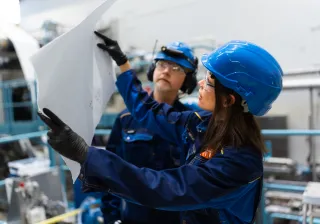With the help of VTT, airlaid material producer SharpCell has worked towards minimising the environmental impact of its products and accelerated the innovation process.
Key facts
SharpCell wanted to further improve the sustainability of the production process and qualities of its airlaid material.
R&D collaboration with VTT has enabled SharpCell to innovate new sustainable solutions.
The cooperation has supported SharpCell’s growth strategy and expansion into new product segments.
Part of the Hypap Group, Finnish family company SharpCell Oy produces airlaid nonwoven paper in its modern production facility in Kausala, Southeastern Finland. Airlaid nonwoven is a type of air-formed paper widely used, for example, in cleaning wipes, hygiene and personal care products and tabletop applications. Committed to minimising the environmental impact of its operations, SharpCell only uses wood fibre refined into pulp as the main raw material for its biodegradable airlaid.
SharpCell has announced an investment in a second airlaid nonwoven paper machine, doubling the company’s production capacity and strengthening its market position.
Nonwovens industry faces sustainability challenges
It has been estimated that currently up to 80% of nonwovens – engineered fabrics made by bonding fibres together through mechanical, thermal or chemical means – are manufactured from oil-based materials. Also, the conventional wetlaid production method for nonwovens is highly energy-intensive, consuming large amounts of water. Pushed by increasing environmental awareness from consumers and tightening regulation – such as the EU’s Single-Use Plastic Directive – the industry is focusing on the development of more sustainable solutions.
Leading the way are airlaid nonwovens, produced using a process that suspends fibres in an air stream and lays them down to form a web, typically using cellulose fibres. This technology eliminates the need for water-based systems and reduces energy consumption, enabling the use of renewable, biodegradable raw materials.
Research and innovation related to nonwovens provide future opportunities for new technologies, more sustainable products and business models.
VTT’s extensive, interdisciplinary know-how has offered valuable extra resources for our relatively small organisation.
Growing airlaid segment expands to new product applications
The cooperation between SharpCell and VTT originally began over five years ago as part of a research consortium with the aim to enhance the product qualities of airlaid nonwovens and make the material even more sustainable and recyclable. Risto Pollari, VP Business Development at SharpCell says that VTT has provided the scientific framework and expertise for studying, for example, what it takes to fulfil the tightening quality requirements of both existing and new product segments.
“VTT’s extensive, interdisciplinary know-how has offered valuable extra resources for our relatively small organisation. Typically, we have provided VTT with samples from test runs on our production line for analyses that we cannot carry out ourselves. For example, VTT has used X-ray tomography to closer examine the structure of our material and developed methods for analysing how to achieve required wet strength with different bio-based binders,” Pollari explains.
He is happy to see that sustainability is rising on the agenda of the entire nonwovens sector, and that major technology suppliers within the paper industry have also begun to invest in developing machinery for nonwovens production.
“Globally, the yearly growth rate of the airlaid nonwoven segment is around 6%, and we are continuously seeing new applications for the material, with new quality requirements. We have, for example, studied the use of airlaid paper in cultivation as a seedbed and barrier against weeds in collaboration with VTT and other partners now for around five years, and are close to commercialising the product,” Pollari says.

Shared goal of finding non-fossil solutions
During the collaboration, VTT has provided SharpCell with:
Deep expertise in sustainable bio-based materials
Research facilities and a piloting infrastructure
An agile R&D process, accelerating innovation efforts.
VTT’s Kristian Salminen, Lead, Bio-based products, says that VTT is a natural partner for nonwoven producers with its extensive know-how in cellulose fibres and development of non-fossil alternatives in areas such as packaging solutions. VTT and SharpCell have also worked in close cooperation on the specifics of VTT’s new piloting environment for sustainable fibre products, to be launched in Jyväskylä at the end of the year.
“Our aim is to expand the use of the sustainable waterless web forming process – used for manufacturing airlaid nonwovens – into new product areas and innovations, such as materials for the packaging, insulation and construction segments. SharpCell has been our partner in developing this technology,” Salminen says.
The new pilot line will be used to study, among other things, the production of fibre fabrics and paperboard using the waterless web forming process, as well as increasing the quality and production speed of the material produced. The aim is also to accelerate the commercialisation of new product innovations in the forest sector and deepen Central Finland's position as a cluster of expertise in fibre-based products and the bioeconomy.
Growth strategy continues with support of partners
Considering the nature of the collaboration, Pollari appreciates the trustworthy relationship and transparent communications established with VTT over the years. In addition, access to an international network of potential partners in co-innovation projects is especially valuable.
“Also, there has been a certain shortage of qualified professionals for the nonwoven segment, and VTT has helped to temporarily fill this gap for us. I’m pleased to see that strengthening the know-how and building a cluster around the expertise is now advancing.”
Looking forward, Pollari says that SharpCell will continue with its ongoing growth strategy.
“The installation of our new paper machine is the next step but certainly not the last. Our vision is to grow together with the market, and we cannot do this without partners such as VTT,” he concludes.








